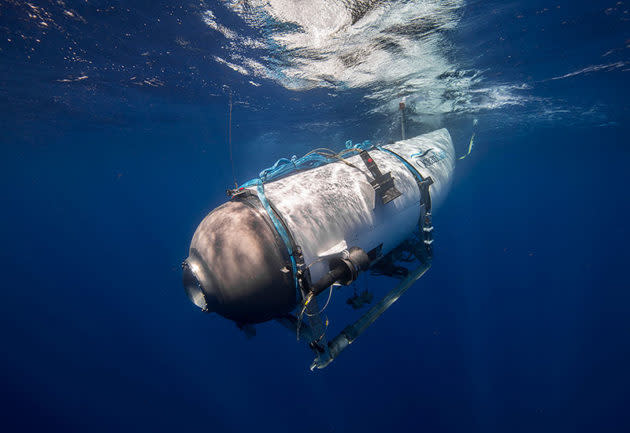OceanGate and NASA are teaming up to build better carbon-fiber pressure vessels

Everett, Wash.-based OceanGate says it’s forged an agreement with NASA to support the development of carbon-fiber pressure vessels that could handle the crushing demands of deep-sea exploration — as well as the strains encountered in the vacuum of space.
The agreement calls for NASA’s Marshall Space Flight Center in Alabama to serve as the site for developing and manufacturing a new type of aerospace-grade hull.
OceanGate said the joint design effort will be key to its plans for building a five-person submersible capable of going as deep as 6,000 meters (19,800 feet). If the company can stick to its current timetable, such a submersible would go into service next year and take on a series of dives to the wreck of the Titanic, at a depth of 12,500 feet in the North Atlantic.
“We continue to receive more demand for Titanic, deep-sea research and environmental supervision of deep-sea mining missions that very few submersibles in the world have the capability of supporting,” OceanGate CEO Stockton Rush said in a news release. “NASA’s advanced composite manufacturing capability is ideally suited for the high precision and high-quality requirements of our hull design.”
NASA also aims to benefit from the partnership as it looks into new breeds of pressurized spacecraft and space habitats for use in Earth orbit and beyond.
“NASA is committed to cutting-edge composites research and development that will not only further our deep-space exploration goals, but will also improve materials and manufacturing for American industry,” said John Vickers, principal technologist for advanced manufacturing technology at NASA. “This Space Act Agreement with OceanGate is a great example of how NASA partners with companies to bring space technology back down to Earth.”
Rush said OceanGate would be paying NASA for its services.
“To have NASA accept the project, it had to meet several requirements, such as advancing technology and being not readily available from commercial sources,” Rush told GeekWire in an email.
Over the past couple of years, OceanGate spent millions of dollars building a carbon-hulled submersible known as Titan, which the company hoped would be capable of diving to the Titanic. However, validation tests conducted at the Deep Ocean Test Facility in Maryland found signs of fatigue in the hull, resulting in a depth rating that ruled out Titanic trips.
Last month, OceanGate reported raising $18.1 million in new investment to support the construction of two new 6,000-meter-class submersibles. And this month, the company put out the call for citizen explorers to join this summer’s expeditions to the Hudson Canyon, off the coast of New York. Those dives will make use of OceanGate’s Cyclops 1 submersible.
More from GeekWire:
OceanGate plans to build submersibles capable of going far below Titanic depths
OceanGate CEO pilots submersible to 4,000-meter depth — to get set for Titanic dives in 2019
OceanGate gears up for deep-sea dives with a crew that’ll pay for the privilege
OceanGate raises $18M to build a bigger submersible fleet and set up Titanic trips

